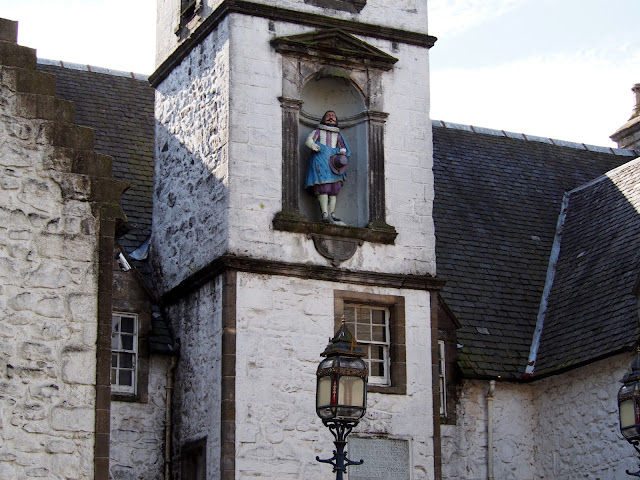We dragged ourselves out of bed on Monday morning, packed up, and set off for Stirling, home of the famous castle and the Battle of Bannockburn.
The nice thing about the UK is that driving distances are comparatively shorter than what we are used to in the USA. We had booked tickets to the Battle of Bannockburn Centre but were early for our appointed time, so continued on to Stirling. It looked very appealing, so after our 3D encounter with Robert the Bruce and his armies and foes, we drove back to the town, parked the car, and walked up the hill to the castle.
The views were fantastic, as always.
I love the narrow streets; walking on cobblestones in minimalist shoes, not so much.
Who could?
The Holy Rude, in case you didn't know, is a piece of the original cross.
Disappointing, I know. I was hoping for something a little more Monty-Python-ish.
In the 1600s, a particularly rambunctious preacher caused such a rift in the congregation that a dividing wall was built down the middle of the church. It wasn't removed until 1936, when the church was renovated. The oak beams of the roof were also exposed at that time.
Note the chairs, which are apparently built for midgets. However, they weren't as bad as the seats we endured when attending evensong at Glasgow Cathedral, which were even smaller and had cane seats. They were excruciatingly uncomfortable. I will never complain about our padded pews again.
It was a steep walk up the hill. Castles, it seems, are almost always built on hills, so we are doomed to spend our days climbing them. On the way, we passed some lovely sweet peas. These are for my sister.
Our old friend, Robert the Bruce, surveying the land.
We walked up to the castle but didn't really want to pay to enter, so we wandered around the gift shop, used the toilets, and started back down the hill. I only mention the toilets because we have decided that the British have bladders of iron. Toilets are treasured and few and far between. One day we stopped to get petrol just so that we could use the facilities, only to find that they un-apologetically didn't have any. Rude!
On the way down, I noticed this sign. Our city's library is also a Carnegie library.
The dear old satnav had been behaving quite well until we tried to find our next airbnb host. The streets of Edinburgh are very narrow and windy, even more than Glasgow, and when the satnav announced that we had arrived at our destination we were clearly on the wrong street. After almost an hour of frustratingly driving around and trying to figure it out, we finally got hold of our host on the phone and he guided us in....to the first place we had stopped! It turns out that streets in Edinburgh change their names frequently and the signs aren't always easy to find.
We were happy to find that our host's flat was immaculately clean and nicely decorated and our room was delightful. We set out immediately to climb Arthur's Seat, which is in Holyrood Park and only a short walk from where we were staying. Not only is Arthur's Seat a dormant volcano, it is also the site of an ancient fort. In all honesty, I have to say that we didn't climb to the tallest point of the peak, which isn't shown in the photos. I shall just say that the climb was a lot harder than it looks, and leave it at that.
But the view was worth it. We could see all the way over the Firth of Forth.
And there is Edinburgh Castle, where our steps would take us the next day.
Going down was much easier than going up.
And by the time we got back to the flat we had worked up an appetite, so we walked to Sainsbury's to buy some food. Just like a local, wending our way along the dark streets and through the tunnels. And we ate bacon and eggs and put our weary selves to bed.
I hope you are enjoying reading about our travels and that (mostly) Jeff's photos are giving you a taste of all of the beauty that we encounter. We are loving Scotland.































































